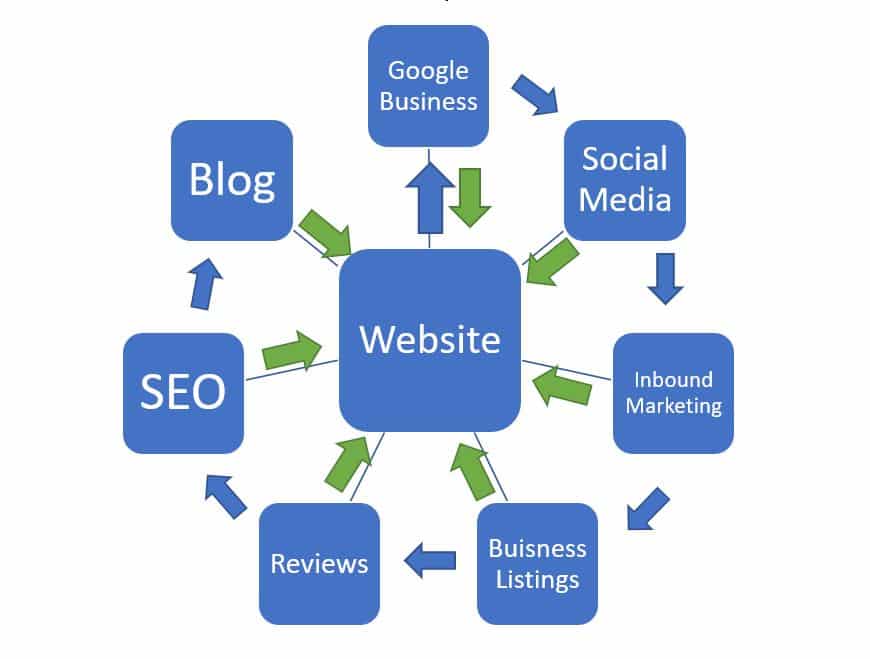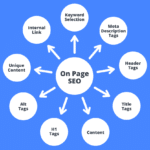Inbound marketing is defined as:
Inbound marketing provides information, an improved customer experience and builds trust by offering potential customers information they value via company sponsored newsletters, blogs and entries on social media platforms.

When you look at the diagram above you’ll see a number of media pillars needed for your success, inbound marketing is one of them. Also, for inbound marketing to work all the other pillars must be part of your priorities. For inbound marketing to work your website will need visitors. To get visitors to your website and convert them into leads you will need an active social media presence. You will need a very aggressive SEO plan of action. SEO is the highest quality of traffic you’ll get to your website because it’s traffic from search engines, from people looking for whatever it is your company sells or provides.
Calls to Action
Calls to actions throughout your website are needed in order to capture user data which can then be used to send newsletters, information and other promotional content to. Now, you might be thinking you don’t want to be annoying and send information to people. Fact is, it works and they are opting in to receive it, they also have the ability to opt out at anytime. In the end capturing user data is always a good idea even if you do not market to them. It can be used for all kinds of things to improve your business. Know a customers history, track their purchases and make notes so when dealing with them again you know their specific customer journey with your business.
What is Inbound Marketing?
Inbound marketing is a strategy that focuses on attracting and engaging customers through valuable and relevant content, rather than actively reaching out to them through traditional advertising methods. The goal of inbound marketing is to create a positive brand experience and build trust with potential customers by providing them with valuable information and resources. This can help to convert them into paying customers over time.
The inbound marketing methodology usually includes the following steps:
- Attract: Use SEO, social media, and other tactics to attract visitors to your website.
- Convert: Use landing pages, forms, and calls-to-action (CTA) to convert visitors into leads.
- Close: Use marketing automation and lead nurturing to close leads into customers.
- Delight: Use CRM, email marketing, and other tactics to delight customers and turn them into advocates.
Inbound marketing can include tactics such as search engine optimization (SEO), social media marketing, content marketing, and email marketing. The main goal is to provide helpful and informative content to potential customers, and provide a positive experience that can turn them into loyal customers.
It’s an holistic approach to marketing and it’s different from the traditional Outbound Marketing (interruptive) that focuses on reaching out to potential customers through channels such as television and radio advertising, telemarketing, and direct mail.
Is Inbound Marketing Expensive?
The cost of implementing an inbound marketing strategy can vary depending on the specific tactics and tools used, as well as the size and complexity of the campaign. In general, inbound marketing can be less expensive than traditional outbound marketing methods, such as television and radio advertising, as it tends to rely more on content creation, social media, and SEO tactics that can be more cost-effective.
However, some inbound marketing tactics, such as SEO and content creation, may require a significant investment of time and resources. Additionally, depending on the industry and competition, it might require more resources to produce great content and attract visitors to the website.
Also, it’s important to note that inbound marketing is not a one-time investment, it’s a continuous process that requires ongoing effort and resources to maintain and improve. The cost of tools and technologies, such as marketing automation software, can also be a factor to consider.
Overall, the cost of inbound marketing can be lower than traditional marketing methods, but it still requires investment and ongoing effort to be successful. It’s important to consider the costs and resources needed and compare them to the expected return on investment (ROI) before starting an inbound marketing campaign.
How Do I Start Inbound Marketing?
Here are some steps you can take to start an inbound marketing campaign:
-
Define your target audience: Understand who your ideal customer is, their pain points, and what they are searching for. This will help you create relevant and valuable content that will attract them to your website.
-
Develop a content strategy: Create a plan for the types of content you will produce, such as blog posts, ebooks, webinars, and infographics, and how often you will publish them. Make sure that your content is valuable and relevant to your target audience.
-
Optimize for search engines: Implement SEO best practices to help your website rank well in search engine results pages (SERPs). This includes optimizing your website’s structure, meta tags, and content for relevant keywords.
-
Build your website: Build or redesign your website to ensure it is user-friendly, visually appealing, and optimized for conversions. Make sure to include calls-to-action (CTA) on key pages to encourage visitors to take action.
-
Promote your content: Share your content across social media platforms and other online communities to increase its reach and attract new visitors to your website.
-
Analyze and refine your strategy: Use analytics tools to track the performance of your inbound marketing campaigns and make data-driven decisions about how to improve them.
-
Use marketing automation tools: Implement marketing automation tools such as email marketing and lead nurturing to automate and streamline your marketing efforts.
-
Measure and track progress: Keep track of metrics such as website traffic, lead generation, and conversion rates to measure the success of your inbound marketing efforts and make adjustments as needed.
It’s important to note that inbound marketing is a continuous process and it takes time to see results. It’s important to be patient and consistent in your efforts, and to regularly analyze and refine your strategy to ensure that it is producing the desired results.
Content Creation for Inbound Marketing
Content creation is a key component of inbound marketing. It involves creating valuable and informative content that will attract and engage potential customers. This can include a variety of formats, such as blog posts, ebooks, webinars, videos, infographics, and more.
Here are some tips for creating effective content for inbound marketing:
-
Understand your target audience: Understand who your ideal customer is and what their pain points and interests are. This will help you create content that is relevant and valuable to them.
-
Use keywords: Research and incorporate relevant keywords into your content to improve its visibility in search engine results pages (SERPs).
-
Create a variety of content types: Use a mix of different content types, such as blog posts, ebooks, webinars, and infographics, to keep your audience engaged and to appeal to different learning styles.
-
Optimize for conversions: Include calls-to-action (CTA) in your content to encourage visitors to take the next step, such as signing up for a free trial or downloading an ebook.
-
Promote your content: Share your content on social media, in email marketing campaigns, and other online communities to increase its reach and attract new visitors to your website.
-
Analyze and refine your content: Use analytics tools to track the performance of your content and make data-driven decisions about how to improve it.
-
Use a consistent brand voice: Use a consistent brand voice throughout all of your content to build trust and establish your brand as an authority in your industry.
-
Make it shareable: Make it easy for your audience to share your content by including social media share buttons on your website.
Content creation is a continuous process and it’s important to consistently produce high-quality, valuable, and relevant content in order to attract and engage potential customers over time. It’s also important to keep track of the performance of your content by using analytics tools and make adjustments as needed.




